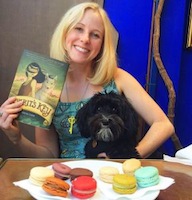From Teaching to Writing

TeachingBooks asks each author or illustrator to reflect on their journey from teaching to writing. Enjoy the following from Edith Cohn.
I’ve wanted to be a writer since I was small enough to read my first books. And as an adult, every job I ever took was one that I thought would give me time to write. I started teaching because I liked the idea of having summers off. And I liked that the school day ended at 2:30. I’d have so much time to write! All the teachers reading this are laughing themselves silly.
Teaching is the hardest job I’ve ever had. I was a part of the Teaching Fellows program, and I took a job teaching 7th grade English for NYC schools. I had three classes in two-hour blocks and a total of 96 kids. Grading the daily writing of 96 kids could be a job in and of itself. Keeping 32 students focused for a two-hour block—well, you all know what a job that is. Teachers should be paid billions if you ask me.
As a writer, how did I teach my kids writing? Maybe not much differently than most teachers. But I’ll highlight a couple of favorite moments.
The first thing I did was tell all the parents and guardians who came to parent-teacher night that I didn’t care what the kids read at home if they were reading. They could read comic books, magazines, video game instructions, cereal boxes—no reading material was bad. Many of the parents were surprised by this, thinking that real reading meant a book, the thicker the better.
I don’t believe you can be a writer without reading. And as most of us know, the first step to creating a reader is for each kid to find something they’re interested in. The second equally important step is easy access to books and independent reading time. The school I was at didn’t have its own library or a librarian. So, I begged for books from every place I could think of and brought a bunch from home to create a classroom library. Many teachers and librarians I know buy their kids the books they need because they know novels, not textbooks, create readers.
I would come into the classroom in the morning or suddenly, look over in the middle of the day, and there would be the most beautiful poem you ever read–like tear your heart out gorgeous.
For books we read together as a class, I made a deal with the kids that I would read aloud a chapter then they would have to silently read a chapter. Most of my kids were reading below grade level, so this method helped get them involved in the story and motivated to read their own chapter. In addition, many of my kids didn’t have quiet time at home to read, so I knew I needed to provide that in the classroom.
I also needed to provide time to write, which we did every day. As a bonus, I hosted a lunch-time writing club. I had a small group of girls to start, and I taught them about critiquing each other’s work. As a writer, I myself am a member of two critique groups, which I find invaluable. And I figured if I could teach my kids how to get their own groups going, they could carry that into the rest of their writing lives. After those girls bonded and formed a group, I started over with a new group of kids.
Another of my favorite writer-teacher moments was during poetry month. I got a magnet board with all these words you could rearrange. I set it up, introduced it, and it took off on a life of its own. Kids would find it when I wasn’t looking and create things with it. I would come into the classroom in the morning or suddenly, look over in the middle of the day, and there would be the most beautiful poem you ever read–like tear your heart out gorgeous. I never knew who wrote most of them, and that was the appeal of it, I think. The kids could be anonymous. It also wasn’t an assignment. I wasn’t standing over them saying, you have to write a poem now. Whoever wanted to could just find a free moment and do it. Maybe there was something fun about the tactile nature of it as well. I think creativity sometimes needs a little mixing up. Write outside, write standing up, write with cut out words from a magazine, write every word with a different colored marker, write listening to music, write while listening to rain and thunder—just try stuff to wake up different parts of your brain. Try stuff just to stay awake. 😉 And always write like no one is looking.
As a teacher, I desperately wanted to be able to pay for all my kids to be able to go on the class field trips.
When I left teaching to pursue writing full-time, I brought my teaching to the page in a way I didn’t expect. My latest novel for middle graders, BIRDIE’S BILLIONS, features a girl named Birdie who doesn’t have much money. Her teacher Mr. Gladwell pays the admission fee for Birdie to be able to go on the class field trip. As a teacher, I desperately wanted to be able to pay for all my kids to be able to go on the class field trips. Only in real life there were too many kids who didn’t have the money, and I wasn’t savvy enough at the time to figure out how to get it for them. I felt so bad for those kids, leaving them behind. So, writing that scene with Birdie was a way I could have a fairy-tale version, where the kid who can’t afford it gets to go on the field trip anyway. Her teacher gets to save the day.
But I also remembered my students, loudly and rightly vocal about how unfair everything was. They knew they’d been dealt a raw deal. Fictional Birdie, too, feels this unfairness. She sees how the other kids can afford things, and she doesn’t want Mr. Gladwell’s charity. She takes it, because she wants to go on the trip. But she isn’t happy about it. She wants her own money. And I know my students did, too. Birdie is lucky enough to get her own money in BIRDIE’S BILLIONS. For a hot minute, she’s rich. I feel lucky to have been able to explore Birdie’s story and bring my experience teaching to her adventures. Teaching is one of the richest adventures out there, and I have no doubt that it will continue to provide inspiration for many stories to come.
Books and Resources

TeachingBooks personalizes connections to books and authors. Enjoy the following on Edith Cohn and the books she’s created.
Listen to Edith Cohn talking with TeachingBooks about the backstory for writing Birdie’s Billions. You can click the player below or experience the recording on TeachingBooks, where you can read along as you listen, and also translate the text to another language.
- Listen to Edith Cohn talk about her name
- Discover Edith Cohn’s page and books on TeachingBooks
- Visit Edith Cohn on her website, Facebook, Twitter, and YouTube.
Explore all of the For Teachers, By Teachers blog posts.
Special thanks to Edith Cohn and Bloomsbury for their support of this post. All text and images are courtesy of Edith Cohn and Bloomsbury, and may not be used without expressed written consent.



Leave a Reply